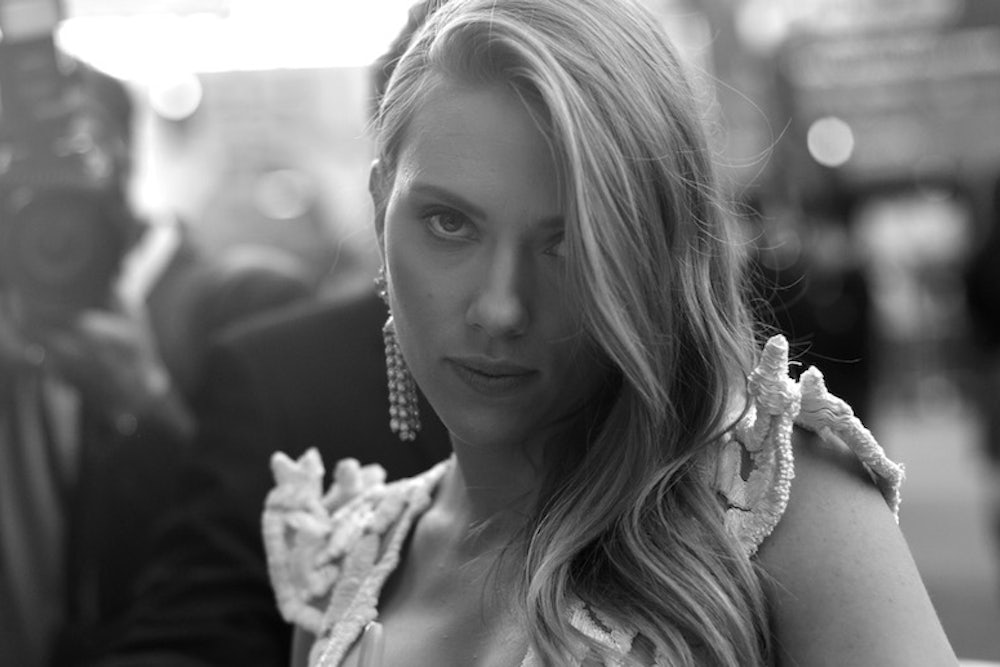Back in the '90s, Tad Friend wrote a long essay in Spin magazine titled “Notes on The Death of the Celebrity Profile.” It was filled with now-familiar complaints: Magazine writers are at the mercy of a p.r. apparatus, which dictates what can be discussed (nothing of substance) and how long an interview can last (as long as it takes the star to finish lunch). A decade and a half later, the celebrity profile keeps chugging along (Friend makes his living writing quite good ones for The New Yorker), but the form reached a new nadir this week, courtesy of Friend’s colleague Anthony Lane and a 5000-word feature on the “Unstoppable Scarlett Johansson.” Lane’s piece, the worst profile I can remember reading in The New Yorker, can be reduced to one basic takeaway: Anthony Lane thinks Scarlett Johansson is radiant, and wants to tell you all about it.
Johansson, who has two movies coming out in the next few weeks and was recently the center of a controversy over her endorsement of SodaStream, isn’t a bad subject. (Though Lane’s question, “Why should we watch Johansson with any more attention than we pay to other actors?” can be easily answered: We don’t.) But he has barely any time with the star: He watches her during a 7-minute photoshoot in a Waldorf-Astoria suite, and hangs around for a while afterwards as one of Johansson's publicists supervises. He’s under strict instructions not to mention Johansson’s pregnancy, and he complies with those terms. He briefly asks her about the Sodastream affair and the Woody Allen controversy, but dispatches with those topics in a few hundred words. He doesn’t supplement this flimsy interview with any other reporting.
So what do you do when you only get a couple minutes of supervised time with a starlet? Writers usually try to make up for this by extracting esoteric meaning from the way a celebrity eats her salad or fries. Unfortunately for Lane, Johansson doesn’t so much as take a drink during their Waldorf-Astoria rendezvous, so instead he describes her as food: “She has played an operating system, using nothing but the honey of her voice.” “She seemed to be made from champagne.” “Then came the laugh: dry and dirty, as if this were a drama class and her task was to play a Martini.” Try to imagine The New Yorker running this about Matthew McConaughey, or Michael Fassbender.
Sadly, this kind of fawning isn’t unusual, as far as profiles of attractive actresses go. (Slate’s Katy Waldman beautifully demolished the piece’s “inappropriate-uncle creepiness” in a post yesterday.) Scarlett has twice been Esquire’s “Sexiest Woman Alive” and was given similar treatment there—accompanied by gauzy photos of her lounging in bed in a translucent tank top and heels. The New Yorker is The New Yorker, of course, and so its camera stays on her cheekbones, not her cleavage (and I’ll be the first to admit that those cheekbones look fabulous), but I prefer my glossy-mag sexism sans highbrow pretensions. When your 5000 words of empty slobbering over an A-list actress is accompanied by a barely-clothed cover shot, the terms of the transaction are upfront: The celeb gets publicity, the magazine gets a bankable star on the cover, and the writer gets … a chance to flirt with a movie star and probably a nice paycheck. There are economic reasons for why Vanity Fair and GQ and Cosmo play this game. What's The New Yorker’s excuse?
